Profile | Who was Lui Shou-kwan? Hong Kong artist fused traditional Chinese ink and abstract art
An émigré from post-war China, in Hong Kong Lui Shou-kwan married Chinese ink art with Western abstract art to forge the New Ink Movement

It has been 50 years since the career of one of the major post-war figures in Chinese art was cut short by his death in Hong Kong.
Lui Shou-kwan, who worked for the municipal government in Guangzhou in southern China, moved to the then British colony with his family in 1948. There, he found work as an inspector for the Hong Kong and Yaumati Ferry Company, a job he held until 1966.
Often finding himself on the piers on either side of Victoria Harbour between which the company’s vessels ferried passengers from Hong Kong Island to Kowloon and back, Lui had a front-row view of some dramatic landscapes.
Born in 1919 in Guangzhou, Lui was the son of Lui Canming, a scholar-painter who owned an antique shop. His father encouraged him to learn how to paint by copying the works of Chinese masters from a young age.